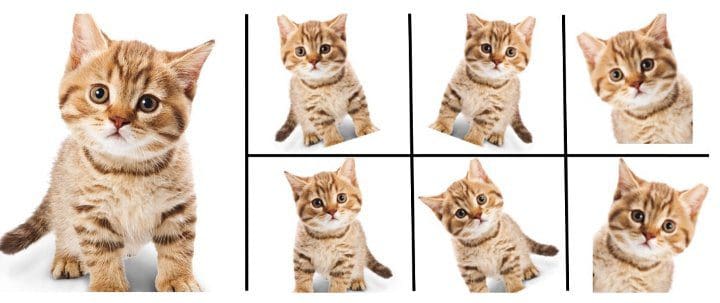Easy Image Dataset Augmentation with TensorFlow
What can we do when we don't have a substantial amount of varied training data? This is a quick intro to using data augmentation in TensorFlow to perform in-memory image transformations during model training to help overcome this data impediment.
The success of image classification is driven, at least significantly, by large amounts of available training data. Putting aside concerns such as overfitting for a moment, the more image data you train with, the better chances you have of building an effective model.
But what can we do when we don't have a substantial amount of training data? A few broad approaches to this particular problem come to mind right away, notably transfer learning and data augmentation.
Transfer learning is the process of applying existing machine learning models to scenarios for which they were not originally intended. This leveraging can save training time and extend the usefulness of existing machine learning models, models which may have had the available data and computation to have been trained for very long periods of time on very large datasets. If we train a model on a large set of data, we can then refine the result to be effective on our smaller amount of data. At least, that's the idea.
Data augmentation is the increase of an existing training dataset's size and diversity without the requirement of manually collecting any new data. This augmented data is acquired by performing a series of preprocessing transformations to existing data, transformations which can include horizontal and vertical flipping, skewing, cropping, rotating, and more in the case of image data. Collectively, this augmented data is able to simulate a variety of subtly different data points, as opposed to just duplicating the same data. The subtle differences of these "additional" images should hopefully be enough to help train a more robust model. Again, that's the idea.
The practical implementation of this second approach to mitigating the problem of small amounts of image training data — data augmentation — in TensorFlow is the focus of this article, while a similar practical treatment of transfer learning will be treated at a later time.
How Image Augmentation Helps
As convolutional neural networks learn image features, we want to ensure that these features appear at a variety of orientations, in order for a trained model to be able to recognize that a human's legs can appear in images both vertically and horizontally, for example. Augmentation, aside from increasing the raw numbers of data points, is able to help us in this regard by employing a transformation such as image rotation in this case. As another example, we could also employ horizontal flip to help a model train to recognize that a cat is a cat whether it is upright or it has been photographed upside down.
Data augmentation is not a panacea; we shouold not expect it to solve all of our small data problems, but it can be effective in numerous situations, and its use can be extended by employing it as one part of a comprehensive model training approach, perhaps alongside another dataset expansion technique such as transfer learning.
Image Augmentation in TensorFlow
In TensorFlow, data augmentation is accomplished using the ImageDataGenerator class. It is exceedingly simple to understand and to use. The entire dataset is looped over in each epoch, and the images in the dataset are transformed as per the options and values selected. These transformations are performed in-memory, and so no additional storage is required (though the save_to_dir parameter can be used to save augmented images to disk, if desired).
If you are using TensorFlow, you might already be employing an ImageDataGenerator simply to scale your existing images, without any additional augmentation. This might look like this:
train_datagen = ImageDataGenerator(rescale=1./255)
An updated ImageDataGenerator which performs augmentation might look like this:
train_datagen = ImageDataGenerator(
rotation_range=20,
width_shift_range=0.2,
height_shift_range=0.2,
shear_range=0.2,
zoom_range=0.2,
horizontal_flip=True,
vertical_flip=True,
fill_mode='nearest')
What does it all mean?
rotation_range- degree range for random rotations; 20 degrees, in the above examplewidth_shift_range- fraction of total width (if value < 1, as in this case) to randomly translate images horizontally; 0.2 in above exampleheight_shift_range- fraction of total height (if value < 1, as in this case) to randomly translate images vertically; 0.2 in above exampleshear_range- shear angle in counter-clockwise direction in degrees, for shear transformations; 0.2 in the above examplezoom_range- range for random zoom; 0.2 in the above examplehorizontal_flip- Boolean value for randomly flipping images horizontally; True in the above examplevertical_flip- Boolean value for randomly flipping images vertically; True in the above examplefill_mode- points outside the boundaries of input are filled according to either "constant", "nearest", "reflect" or "wrap"; nearest in above example
You can then specify where training (and optionally validation, if you were to create a validation generator) data are located, using the ImageDataGenerator flow_from_directory option, for example, and then train your model using fit_generator with these augmented images being flowed to your network during training. A sample of just such code is shown below:
train_generator = train_datagen.flow_from_directory(
'data/train',
target_size=(150, 150),
batch_size=32,
class_mode='binary')
# assuming model already defined...
history = model.fit_generator(
train_generator,
steps_per_epoch=100,
epochs=100,
verbose=2)
And there you have it. An intro to easy image dataset augmentation in TensorFlow.
Related:
- 4 Tips for Advanced Feature Engineering and Preprocessing
- 5 Great New Features in Latest Scikit-learn Release
- Pedestrian Detection Using Non Maximum Suppression Algorithm

